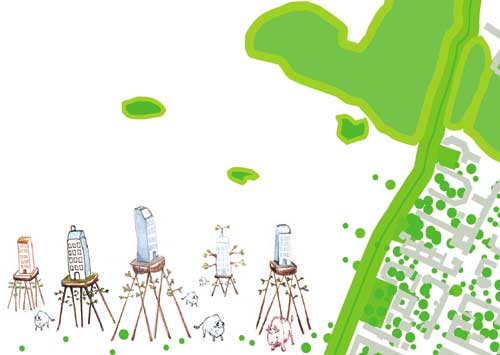 |
|
Opening:
27 August 2010, 8PM |
| Art
Laboratory Berlin is pleased to announce the opening of the exhibition
Wunschgarten: Wild Urban Offshoots by the artists Alex
Toland and Myriel Milicevic - the second exhibition in our ongoing
series Artists in Dialog.
Each exhibition in Artists in Dialog takes the form of a discourse between two artists, whose work has a common point of contact (e.g. aesthetics, theme or process). Alex Toland and Myriel Milicevic both work on the border between art and life and environmental sciences. Toland considers the project 'habitat hacking' and Milicevic describes the project as 'reconstructing cross-species life worlds'. Together they have chosen the immediate area around Art Laboratory Berlin (the Soldiner Kiez) as a place to investigate interactions between the local human population and urban flora and fauna. The exhibition space will function as a laboratory for mapping, sketching, modelling and prototyping. Wunschgarten is a series of dialogues: between the artists and the local community, between city dwellers and nature, between urban planning and urban wilderness. As
cities creep further into wild landscapes, the wild moves into cities.
Urban habitats are places where plants and animals take up residence
alongside people. Too often though, space for nature is sealed off
by concrete constructions, resulting in a marked divide between
the space occupied by humans and the rest of the biotic community.
The Wunschgarten is an exploration of the city's wild features
and creatures, and a vision of utopian measures that reach beyond
existing mitigation schemes and municipal green-space planning.
The city becomes a garden of unexpected edible opportunities and
ideas to incubate and explode. Toland and Milicevic start their investigation by mapping the various food sources available in the neighbourhood: 1. Local food sources (such as gardens that are planted by the human population, but also the green areas which provide a source of nourishment for the local fauna); 2. Travelled foods (all things brought in and sold at such places as restaurants, cafes, kiosks and markets). They then go on to explore future options for common production, co-production and co-habitation between human urban dwellers and local fauna. Typical planning concepts of "life world oriented space" and "potential natural vegetation" are trumped with visions of potential natural inhabitants, considering for example, the re-introduction of former megafauna such as the European bison. How might migrating bison find the delicious clover hiding between the bricks and pavement? And how will the ants cross the Osloer Strasse to carry the seeds of the healing Calendine? After mapping existing food sources, the artists propagate some new offshoots, coming up with creative measures to address problems of fragmentation and isolation of urban green space and its myriad inhabitants. Elevating buildings on tree stilts creates grazing space for large mammals. "Formicidae funiculars", or cable cars for non-winged insects, run alongside the tramways, bringing ants and their kin to new Calendine patches. Stony houses allow mountain goats to climb upon them and graze on rooftop farms… The list of mitigation measures sprouts and grows. The
artists reflect in their project possible tools that might help
people to interact and communicate with animals and plant life in
the neighbourhood: A telescope for recognizing local birds, a seed
apron to help plants disperse, a bird house backpack for hatching
migrating birds... Coinciding with the early harvest season of late
summer, such tools as well as other measures will be developed in
the streets and courtyards of the Soldiner Kiez and in a series
of workshops and neighborhood walks based out of the offshoot lab
(Art Laboratory Berlin). To explore these possibilities in a more concentrated setting, there will be a workshop on September 4 led by the artists to discuss and investigate, create and formulate, construct and co-inhabit the Wunschgarten and its wild urban offshoots. . Alex
Toland is a visual artist and environmental researcher based
in Berlin. In 2009 she presented her performance and interactive
urban exploration Personal Dispersal Mechanisms at Art Laboratory
Berlin.(http://artlaboratory-berlin.org/html/eng-event-5.htm)
Alex has an MFA from the Dutch Art Institute (DAI) and Dipl. Ing.
in landscape architecture and environmental planning from the TU
Berlin. She is currently a graduate research fellow in the Graduate
Research Program "Perspectives on Urban Ecology." Myriel
Milicevic is a visual artist, researcher and interaction designer
based in Berlin. With her Neighbourhood Satellites she explores
the hidden connections between people and their natural, social,
and technical environments. She received her MA from the Interaction
Design Institute Ivrea, Italy and her diploma in Graphic Design
from the Gerrit Rietveld Academie, Amsterdam.
|
| sponsored by: | ||||||
 |
||||||
